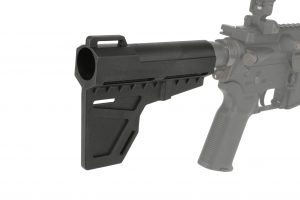 I recently received a call from a client who had received his approved Form 1 for a self-manufactured suppressor. The Form 1 application had been submitted pre-41F via eForms.
I recently received a call from a client who had received his approved Form 1 for a self-manufactured suppressor. The Form 1 application had been submitted pre-41F via eForms.
In reviewing the approved form in preparation for having his tube engraved, he was confused as to why box 4a did not contain his trust name, city, and state as the original manufacturer.
Instead, it simply said:
FORM 1 REGISTRATION, UNITED STATES

His confusion was increased by the fact that one of his friends had an approved Form 1 for an SBR that was also entered via eForms and box 4a on that approved form contained the name of the original manufacturer of the lower.
He was very concerned and had two questions that he wanted answered:
a) Where did this come from and does it indicate that his approval is invalid; and
b) If the approval is valid, how does this impact his engraving requirements.
Let’s address these in the order asked.
Where does this come from?
The short answer is that this is an artifact from the much-maligned and mercurial eForms system (which is no longer available to trust applicants post-41F).
As for why this is the case, in the ATF eForms Bulletin from December of 2013 entitled ‘EForms 101’ (embedded below), on the top of page 10 we see the following (emphasis added):
If the applicant is creating the firearm (for example, a silencer or finishing an ‘incomplete receiver’ (that is not yet a firearm)), the applicant will be the maker under the NFA and GCA. Thus, when completing the Line Item (Add Firearm) field, click the “By Manufacturer Code’ button and enter the code ‘FMI’. This code stands for ‘Form 1 Registration’ and the entry can continue. …
If the applicant is modifying an existing firearm, typically a standard configuration rifle into a short barreled rifle, the applicant will still be the maker under the NFA but there will be a manufacturer under the GCA, thus, the form requires the name of the original manufacturer of the firearm.
Download (PDF, 1.49MB)
So we see that, when using eForms as directed by the ATF and self-manufacturing a suppressor or building an SBR from an ‘incomplete’ (non-serialized) lower, the manufacturer was to be entered as ‘FMI’ which would result in box 4a containing “FORM 1 REGISTRATION, UNITED STATES”.
Alternatively, when using eForms to submit a Form 1 for an SBR build using an already serialized lower or upper, the manufacturer was selected from the list of licensed manufacturers and box 4a would then contain the name and address of the original manufacturer of the lower or upper.
I should note that, at various times during its service life, eForms did allow freeform entry of trust name in the manufacturers field and in almost all of these cases, the examiner would change the entry to FMI prior to approving the Form 1. Conversely, all pre-41F paper Form 1’s will have the trust name and address in box 4a.
But these system-created variances do not in any way call into question the validity of these approved Form 1’s. If the registrant’s information is correct, the serial number is correct and properly marked on the item, the making tax has been paid, and the ATF examiner has approved the Form 1, then the Form 1 is valid.
Good. Now how does this affect my engraving requirements?
Let’s start by clarifying our terms. When you are building an NFA item for yourself or your trust you are a maker, not a manufacturer. If you look closely at the top of a Form 1 you will see that it is an Application to Make and Register a Firearm.

27 CFR 478.92 and 27 CFR 479.102 both lay out the requirements for placing identifying markings on items you make or manufacture.
Specifically, 27 CFR 479.102 requires that:
“You, as a manufacturer, importer, or maker of a firearm, must legibly identify the firearm as follows (emphasis added):
…
(2) By engraving, casting, stamping (impressing), or otherwise conspicuously placing or causing to be engraved, cast, stamped (impressed), or placed on the frame, receiver, or barrel thereof certain additional information.
…
(iii) Your name (or recognized abbreviation) and also, when applicable, the name of the foreign manufacturer or maker;”
Note that nowhere does it mention the specific contents of Form 1 box 4a. The contents of this form are submitted for the purposes of informing the examiner processing the Form 1 application and not for the purpose of informing the engraving process.
The regulations are clear on what needs to be engraved. When engraving a self-manufactured item with no original serial number, you need to engrave the following:
- Trust Name, City, and State
- Model
- Serial Number
- Caliber


 I recently received a call from a client who had received his approved Form 1 for a self-manufactured suppressor. The Form 1 application had been submitted pre-41F via eForms.
I recently received a call from a client who had received his approved Form 1 for a self-manufactured suppressor. The Form 1 application had been submitted pre-41F via eForms.

 This is a question that arises quite frequently. “If my (husband / wife / boyfriend / girlfriend / parent / roommate) is a prohibited person does that mean I can’t have my legally owned firearms in my own home?”
This is a question that arises quite frequently. “If my (husband / wife / boyfriend / girlfriend / parent / roommate) is a prohibited person does that mean I can’t have my legally owned firearms in my own home?” The criteria for which types of mental health issues might give rise to a gun rights prohibition under either state or federal law is staggeringly complex.
The criteria for which types of mental health issues might give rise to a gun rights prohibition under either state or federal law is staggeringly complex. In the Fall of 2014, I wrote about
In the Fall of 2014, I wrote about 



